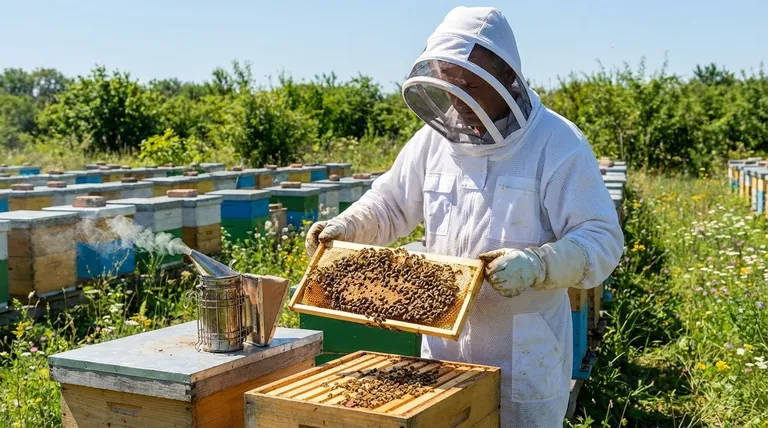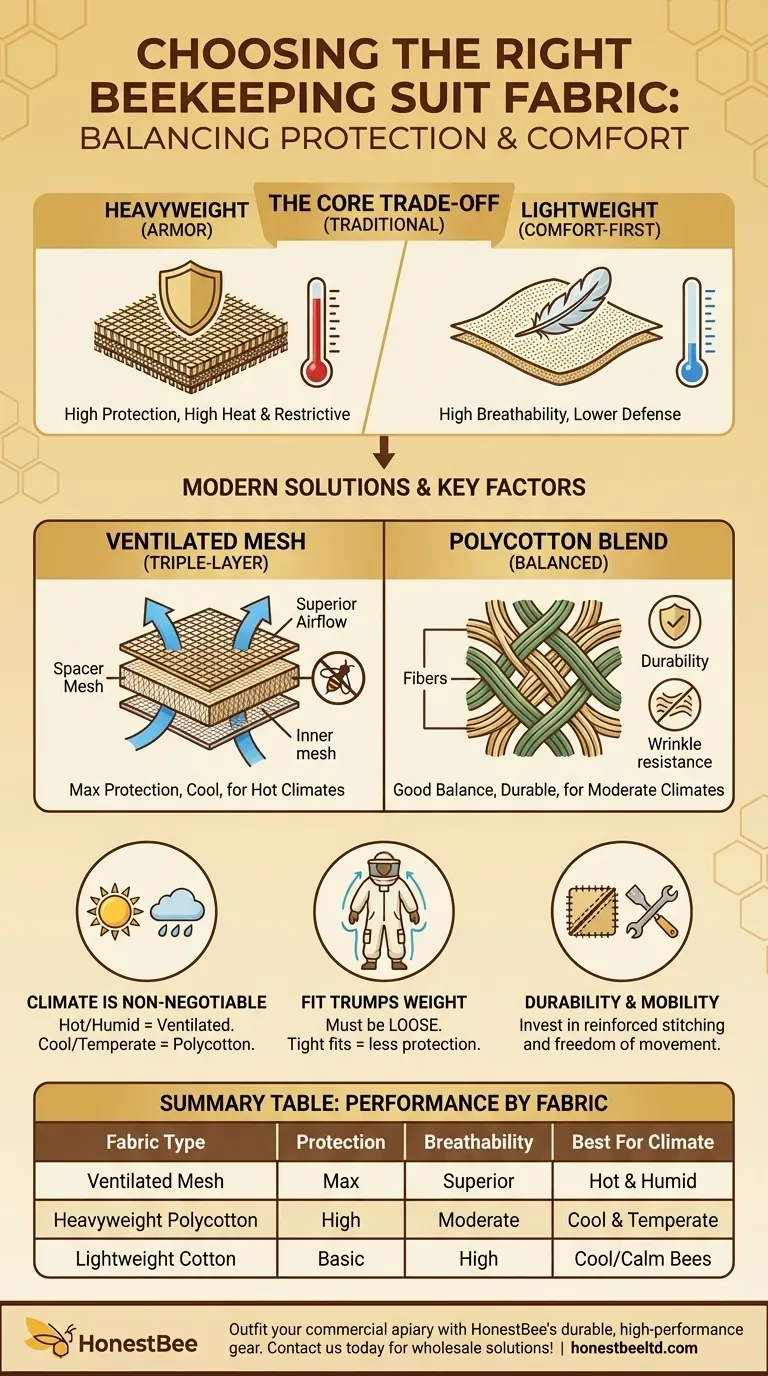When choosing a beekeeping suit, the fabric weight is a critical decision that directly impacts both your safety and your comfort. The fundamental choice is between heavier fabrics, which offer superior protection from stings but can be hot and restrictive, and lighter fabrics, which are more breathable but may offer less defense. Modern material innovations, however, have largely resolved this traditional compromise.
The best choice is no longer a simple trade-off between heavy protection and lightweight comfort. For most beekeepers, particularly those in warmer climates, a multi-layer ventilated mesh suit offers maximum sting protection while providing superior airflow and comfort.

The Core Trade-Off: Protection vs. Comfort
Historically, a beekeeper had to choose one priority over the other. Understanding this traditional balance helps clarify the value of modern suit designs.
Heavyweight Fabrics: The Traditional Armor
Heavier materials, like thick cotton canvas or dense polycotton blends, provide protection by creating a physical barrier a bee's stinger cannot easily penetrate.
The significant drawback is heat retention and reduced breathability. Working in a heavy suit on a hot day can lead to overheating and fatigue, which is a safety risk in itself.
Lightweight Fabrics: The Comfort-First Approach
Lighter cotton or nylon suits prioritize comfort and mobility. They allow for much better air circulation, making them more pleasant to wear during long inspections in the summer.
However, their protective capability is lower. If a lightweight suit fits too snugly or is pulled taut while you bend or reach, it offers little to no protection from a determined bee.
Moving Beyond Weight: The Role of Modern Materials
Advances in textile technology mean you no longer have to sacrifice safety for comfort. The design and construction of the suit are now just as important as the raw weight of the fabric.
Ventilated Suits (Triple-Layer Mesh)
This is the modern solution to the age-old problem. Ventilated suits use a three-dimensional mesh fabric, often a thick spacer mesh sandwiched between two layers of finer mesh.
The thickness of the mesh (typically 3-5mm) creates a gap that is wider than the length of a bee's stinger. This provides excellent protection while allowing air to flow freely through the suit, keeping you remarkably cool.
Polycotton Blends
A blend of polyester and cotton remains a popular middle-ground option. It offers better durability and wrinkle resistance than 100% cotton while maintaining a good degree of breathability.
These suits represent a good balance of protection, comfort, and cost, making them a solid choice for beekeepers in moderate climates or those on a budget.
Understanding the Key Factors and Trade-offs
Choosing a suit is about more than just the material. Your specific context determines the right combination of features.
Climate Is Non-Negotiable
Your local climate is the most important factor. In a hot and humid region, a heavyweight cotton suit is impractical and potentially dangerous due to the risk of heat exhaustion.
For hot climates, a ventilated mesh suit is the unequivocal best choice. For cooler, more temperate regions, a thick polycotton blend can provide adequate warmth and protection.
Fit Trumps Fabric Weight
A suit’s protective capability is nullified if it’s too tight. A baggy fit is essential, as it creates additional space between the fabric and your skin.
When trying on a suit, you should be able to squat, bend, and reach without the material pulling tight across your back, shoulders, or knees. A tight suit is an open invitation for stings, regardless of how "heavy" the fabric is.
Durability and Mobility
A good suit is an investment that must withstand branches, hive tools, and repeated washing. Durable fabrics and reinforced stitching prevent tears that would compromise protection.
Look for suits designed with extra room in the shoulders and crotch. This ensures you can move freely and perform necessary tasks without the suit restricting you or pulling tight.
Making the Right Choice for Your Goal
Your final decision should be guided by your environment and the nature of your beekeeping work.
- If your primary focus is maximum protection in a hot or humid climate: A multi-layer ventilated mesh suit is the best possible investment for your safety and comfort.
- If your primary focus is balancing performance and cost in a moderate climate: A high-quality, mid-to-heavyweight polycotton suit with a loose fit offers a reliable and effective solution.
- If your primary focus is occasional use with known calm bees: A basic, lightweight cotton suit may be sufficient, but you must ensure it is worn very loosely to provide a gap between the fabric and your skin.
Ultimately, the right suit is one that allows you to work confidently and focus on the health of your colony, not the fear of a sting.
Summary Table:
| Fabric Type | Protection Level | Breathability | Best For Climate |
|---|---|---|---|
| Ventilated Mesh | Maximum | Superior | Hot & Humid |
| Heavyweight Polycotton | High | Moderate | Cool & Temperate |
| Lightweight Cotton | Basic | High | Cool, Calm Bees |
Ready to outfit your commercial apiary or distribution business with the right beekeeping suit? HONESTBEE supplies durable, high-performance beekeeping supplies and equipment designed for the demands of professional beekeepers. Our wholesale-focused operations ensure you get the best value on gear that keeps your team safe and productive. Contact us today to discuss your needs and request a wholesale catalog!
Visual Guide

Related Products
- Cotton Beekeeping Suit and Round Hat with Veil Bee Keeper Protective Gear
- Beekeeping Jacket with Hood and Veil for Beekeepers
- Economy Polyester Beekeeping Jacket with Veil and Hat
- White Beekeeping Protective Suit and Hat with Fencing Veil for Beekeepers
- Heavy Duty Cowboy Beekeeper Hat with Visibility Veil Outdoor Professional Beekeeping Protective Gear
People Also Ask
- Why is a jacket with a hat veil recommended for beekeepers? Essential Protection for Your Face and Neck
- Why is white the predominant color in bee suit designs? | Key to Hive Calm & Beekeeper Safety
- What are the benefits of a fully ventilated beekeeping suit? Stay Cool and Protected in Hot Climates
- How should a bee suit be cleaned? Protect Your Investment and Ensure Apiary Safety
- What factors should be considered when choosing a beekeeping suit? Balance Safety, Comfort & Performance



















